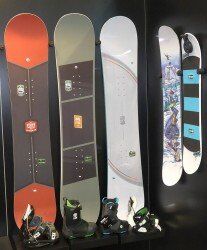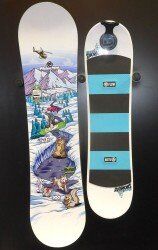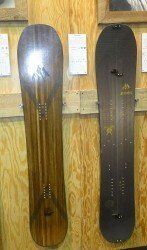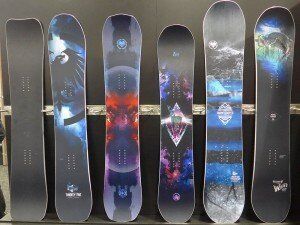Mountain Weekly News ~
Teton Pass, Wyoming
Everyone has heard of the legendary skiing and ridding at Jackson Hole, however it’s not just the ski resort the offers access to incredible backcountry terrain. Just up the road separating Idaho from Wyoming lies Teton Pass. This well known Pass only has 100 parking spots so don’t be surprised if you’re not alone waiting to slide into a spot up top. The Pass offers plenty of pow for everyone whether you plan on booting up Glory or skinning on the south side odds are a day on Teton Pass will leave you stoked, tired and wanting more.
Vail Pass, Colorado
Untamed powder waits on Vail Pass, the famous backcountry spot in Colorado just off I-70. With miles and miles and more miles of the land to cover, you could ride for a long time with the assist of a snowmobile. Be sure to check road conditions and the Colorado Avalanche Information Center (CAIC) before heading into this zone.

When Not working Patrol at Beaver Creek Garret Owmby heads to the Pass Photo Ben Koelker | Mountain Weekly
Mount Graylock, Massachusetts
Take a short drive west from Albany, New York and you’ll end up at Mount Graylock, home of Thunderbolt Trail, where the 1936 United States Eastern Alpine Championships were held. With a 35 degree pitch, who wouldn’t want to ride a slope like that? There are also many other trails with over 2,050 feet of vert. The view from the top looking over the Catskills and many other mountains, the hike won’t even be that bad.
Just about all these locals have one thing in common. They would crush it with a Lib Tech Hot Knife snowboard!
Loveland Pass, Colorado
Along with Vail Pass, Loveland Pass is another fun backcountry are to ride in. The characteristics of this high alpine zone set it apart from some of the other areas we mentioned in this article. The views here are incredible however the snow gets a lot of wind, so be mindful of playing in avalanche terrain.
Wait pump the breaks, what about the best helmet for snowboarding? We picked our favorites year after year to review. Checkout these lids before your next shred vacation.
Berthoud Pass, Colorado
To get the best runs at Berthoud Pass you’ll have to earn it with a hike to the top. Secret powder stashes and long runs will bring you right back to your car or an easy hitch back to the top of the pass.
These are just a few of the amazing free backcountry runs in the U.S. Keep looking, there are plenty more runs for you to find. Be safe out there and always check the avalanche information center forecast in your area before attempting to ski or ride in the backcountry.
Your Own Backyard
The best way to save money on your next ski trip is to select a destination that is within driving distance of your home. Obviously, the shorter the drive, the more money you will save. Fortunately, killer ski areas are located all across the country, even in some very unlikely places. For some lucky shredders going snowboarding can be as easy as walking out your backyard.
Mt. Baker
Skiing at Washington State’s Mt. Baker could save you some serious cash. Mid week lift tickets are only $50 a day, less then half of some of the other major ski resorts in the country. Best of all, there is plenty of cheap lodging near the mountain, ranging from cabins in nearby Glacier to hotels, apartments, and condos in Bellingham an hour away. Check out Baker Accommodations and tell Kai you heard about them through the Mountain Weekly News
Salt Lake City
Utah’s Salt Lake City is a great home base for skiers and snowboarders that like to hit multiple mountains in a single trip. With more than eight top-quality ski resorts within an hour’s drive, the city offers a little something for everyone. Best of all, if you avoid the uber-popular and uber-expensive spots like Park City and Canyons, you can actually find some pretty solid deals. The area is packed full of local backcountry zones that only take a little lung power and leg power to reach.
Bend, Oregon
Want to ski on the cheap? Bend, Oregon’s Mt. Bachelor offers some of the most affordable deals for skiers and snowboarders in the Pacific Northwest. Lodging is cheap, there are a plethora of nearby breweries, and the scenery is wonderful. There is a reason legendary surfer Gerry Lopez calls Bend Oregon home.
Taos, New Mexico
Those that have not visited in the winter might not think of Taos, New Mexico as a skiing and snowboarding hot spot. But it is. Rates are mostly affordable although its slopes are generally best suited for riders with a little more experience under their belts. Taos Ski Valley is also home to one of the top-rated skiing schools in the country.
Ski Resorts in the US Uphill Policies
by Ben Osborne
While riding the lifts is a nice luxury, there are other ways to get out there and make some turns. We appreciate resorts that allow us onto their mountains by our own will rather than having to pay a kings ransom, and we encourage every resort, if its in their best interest and the interest of the safety of the public, to adopt similar policies in order to allow everyone to enjoy the shred! Thank you kindly.
Colorado Ski Resorts
Crested Butte – Buy a day ticket for $10, buy a season pass for $100, and skin like a free man/woman.
Aspen — Allowed, however you must be wearing a mink coat. No just kidding
Vail – Call before, but allowed—there are lots of rules… I mean it’s Vail, what did you expect.
Beaver Creek– Allowed, but call before.
Telluride – Prohibited during offseason, Allowed on Lift 10 only.
Wolf Mountain – Allowed any time during operating hours! Party on Wayne.
SKI LAW IN COLORADO
Make sure to check up on backcountry policies according to state law—these can be important in rescue situations.
Montana Ski Resorts
Montana, probably not the most welcoming. I think they prefer you buy a snowmachine to get up into the mountains…
Big Sky – Not allowed during operational season
Bridger Bowl – Not allowed during operational season
Moonlight – Not allowed during operational season
Whitefish – Allowed
Oregon Ski Resorts
Bachelor – Allowed, check website for rules
Timberline – Ticket required!
New Hampshire Ski
Cannon – Only during resort hours, check website for prescribed route!
Waterville – Allowed pre/post season, not allowed during season
Loon – Allowed during operational hours, 2 hours before—must have season pass or purchase uphill ticket for 20$
Utah Ski Resorts
Alta – Not allowed during operational dates, pre and post season allowed UNLESS POSTED!
Solitude, Canyons, Deer Valley – NOT ALLOWED ANYTIME!
Snowbird – Prohibited from 9-5, allowed otherwise unless Inter lodge is happening.
Vermont Ski Resort
Jay Peak – Not allowed outside of operational hours, allowed during though!
Stowe – Not allowed during operational hours, allowed after though! Be mindful of rules and snowcats at night, lots of night traffic on this mountain.
Mad River – Only allowed during non-operational hours.
Stratton – Allowed, check website for trail information and guidelines.
Washington Ski Resort
Alpental – Allowed, check in with ski patrol before you skin!
Crystal – Allowed, but play by the rules.
Stevens Pass – Check in with patrol, play by rules! Stevens Reserve right to limit traffic any time.
Mt. Baker Ski Area – Game on, you may even just find the GM Duncan snowshoeing around with his dog!! We like the tours from the upper parking lot..
Wyoming Ski Resort Uphill
Jackson Hole – Not allowed, ask the 78 year old man who was arrested a few years ago after refusing ski patrollers’ orders to stop. Doug would be proud..
Grand Targhee – Allowed in some places, during some times, changes during operational and non operational hours.
Snow King Resort – The town of Jackson tradition continues this year however there are a few changes. The Resort is asking users to obtain an uphill pass which is free of charge, however a shinny pass holder will set you back $7.50, ok that’s random.. Monday’s are great, fun. Pickup your dogs poop please..
-Always check the conditions, weather, and avalanche report (even if you are inbounds)
-Pay close attention to rules, laws, and guidelines regarding the state, resort, and area you choose to explore—each state has different and complicated rescue and trespassing laws.
-No matter whether you are going 20 miles deep into the backcountry, touring up your local hill just after it closes, or going on a moonlit ski, the most important safety precaution you can take is to tell someone where your going and when you will be back!
-Even though some resorts allow uphill skiing and may not have developed a official policy, don’t be a jackass. Because then once they do make a policy, the policy is gonna suck.
-When your hiking up the resort, do your best to make everyone’s’ life around you easier—aka the paying customers, the cat drivers, and the employees, because you get to shred for free.
Remember to always check the hills website or call before heading out, no matter what this page says. These are just guidelines… Who knows you may just enjoy earning your turns!!! We sure do
The post Best Backcountry Skiing and Riding in North America appeared first on Mountain Weekly News by Jeremy Shurites.






















































































































































































































































































































